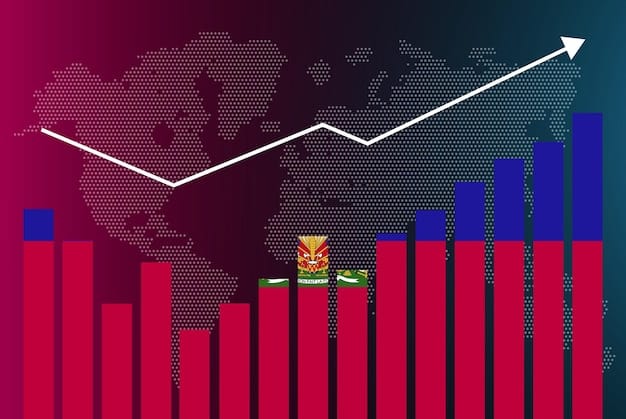Investing in Emerging Markets: Navigating High-Risk, High-Reward Opportunities

Investing in emerging markets presents a unique opportunity for high returns, but requires careful consideration of the associated risks, including political instability, currency fluctuations, and regulatory uncertainties.
Are you looking to diversify your investment portfolio and potentially earn higher returns? Investing in emerging markets could be the answer. However, it’s crucial to understand the risks involved before diving in.
Understanding Emerging Markets
Emerging markets are nations with economies transitioning from developing to developed status. These countries often exhibit rapid growth, industrialization, and increasing integration into the global economy. This dynamic environment presents both significant investment opportunities and considerable risks.
These markets can offer higher growth potential compared to developed economies. Due to their relative instability and lower levels of market maturity, investing requires in-depth understanding and planning.
Characteristics of Emerging Markets
Identifying emerging markets involves looking at several key indicators. These countries typically show distinct characteristics that differentiate them from developed nations.
- Rapid Economic Growth: Emerging markets often experience higher GDP growth rates compared to developed nations, driven by factors like industrialization and urbanization.
- Increasing Industrialization: Many emerging economies are undergoing rapid industrialization, leading to increased productivity and economic diversification.
- Growing Middle Class: The expansion of the middle class in these countries drives consumer spending and supports domestic businesses.
- Developing Infrastructure: Investments in infrastructure, such as transportation, energy, and communication networks, are crucial for sustained growth.
Understanding these characteristics is crucial for investors to gauge the potential and challenges of investing in these markets.
In conclusion, emerging markets offer a mix of exciting opportunities and significant challenges. Investors need to carefully assess factors like political stability, market maturity, and regulatory environment. Doing so helps informed decisions that can harness the high-growth potential of these economies.

Potential Benefits of Investing in Emerging Markets
Investing in emerging markets can be a game-changer for your investment portfolio, offering benefits not typically found in developed markets. However, these benefits come with their own set of caveats.
The appeal of emerging markets lies in their potential for higher returns and diversification, which can significantly enhance a portfolio’s overall performance.
Higher Growth Potential
Emerging economies often outpace their developed counterparts in terms of economic growth. This rapid expansion can translate into substantial returns for investors who get in early.
Diversification Benefits
Emerging markets typically have low correlations with developed markets. Adding them to your portfolio can reduce overall risk by diversifying your investments across different economies and asset classes.
In sum, the potential benefits of investing in emerging markets are compelling. However, realizing these benefits necessitates a well-informed and strategic approach, always mindful of the risks involved.
Understanding the Risks
While the allure of high returns in emerging markets is strong, it’s crucial to be aware of the inherent risks. These risks can significantly impact your investment if not properly understood and managed.
The volatile nature of these markets demands a thorough understanding of the potential pitfalls and strategies to mitigate them.
Political Instability
Emerging markets can be prone to political instability, which can lead to abrupt changes in government policies and regulations, affecting investor confidence.
Currency Fluctuations
Currency values in emerging markets can be highly volatile. Fluctuations can erode returns when investments are converted back to your home currency. Hedging strategies can mitigate this risk, but at a cost.
Regulatory and Legal Challenges
Emerging markets often have less developed legal and regulatory frameworks compared to developed countries. This can lead to uncertainty and increased risks for investors. Navigating these challenges requires careful due diligence and compliance.
Liquidity Risk
Some emerging markets have lower trading volumes and liquidity compared to developed markets. This can make it difficult to buy or sell investments quickly without affecting prices. Investors need to be prepared for potential delays and price volatility.
- Evaluate the political landscape and assess the stability of the government.
- Monitor currency movements and consider hedging strategies.
- Understand local laws and regulations and ensure compliance.
- Assess liquidity conditions and be prepared for potential delays.
In closing, the risks associated with investing in emerging markets are significant but manageable with the right approach. Awareness and preparedness are vital for success.
Strategies for Successful Investing
Investing in emerging markets requires a strategic approach to capitalize on the opportunities while mitigating the risks. A well-thought-out strategy can significantly increase your chances of success.
Diversification, due diligence, and a long-term perspective are key components of a successful investment strategy in emerging markets.
Diversification
Diversify your investments across different emerging markets and asset classes to reduce the impact of any single market or sector performing poorly.
Due Diligence
Conduct thorough research on the specific companies, industries, and countries you plan to invest in. This includes understanding their financial health, competitive positioning, and regulatory environment.
Long-Term Perspective
Investing in emerging markets is often a long-term endeavor. Be prepared to ride out short-term volatility and focus on the long-term growth potential.
To conclude, successful investing in emerging markets hinges on diversification, due diligence, and a long-term outlook. Smart tactics ensure that you are in a good position to benefit from the high-growth possible, all while lowering the risks involved.

Examples of Emerging Markets
Several countries around the world are classified as emerging markets, each with unique characteristics and investment opportunities. Familiarizing yourself with some key examples can provide a better understanding of this diverse landscape.
Understanding these specific markets can offer insights into the varied opportunities and risks associated with emerging market investments.
China
China is one of the world’s largest and fastest-growing economies. Its vast manufacturing sector and growing consumer market offer significant investment opportunities. However, investors must navigate regulatory complexities and political risks.
India
India boasts a large and young population, a rapidly growing middle class, and a thriving technology sector. Its diverse economy offers opportunities in various sectors, but infrastructure challenges and bureaucratic hurdles persist.
Brazil
Brazil is the largest economy in Latin America, with abundant natural resources and a diverse industrial base. However, political instability and economic volatility can pose challenges for investors.
Southeast Asia
Countries like Vietnam, Indonesia, and the Philippines offer attractive investment opportunities due to their growing economies, young populations, and increasing integration into global supply chains. Investors should be aware of varying levels of political and economic stability across the region.
In short, emerging markets like China, India, Brazil and Southeast Asia each offer unique investment landscapes. Getting a handle on the subtleties of each country is essential for navigating their potential and challenges.
Future Trends in Investing
The landscape of emerging market investment is constantly evolving, driven by technological advancements, shifts in global economics, and changing investor preferences. Keeping abreast of these changes is crucial for investors looking to stay ahead of the curve.
Technological innovations, sustainable development, and increased investor interest are shaping the future of emerging market investments.
Impact of Technology
Technological advancements are transforming emerging markets, creating new investment opportunities and driving economic growth. Fintech, e-commerce, and digital infrastructure are key areas to watch.
Sustainable and Impact Investing
There is a growing interest in sustainable and impact investing in emerging markets. Investors are increasingly focusing on companies and projects that promote environmental sustainability and social responsibility.
Increased Institutional Investment
Institutional investors, such as pension funds and sovereign wealth funds, are increasingly allocating capital to emerging markets. This trend can lead to greater market liquidity and stability.
- Focus on companies fostering digital transformation and innovation.
- Seek out opportunities that promote sustainability and social impact.
- Keep an eye on the allocation strategies of institutional investors.
Overall, the future of investing in emerging markets is exciting and full of changes. Staying informed helps to capitalize on new possibilities as they emerge.
| Key Point | Brief Description |
|---|---|
| 🚀 High Growth Potential | Emerging markets offer rapid economic expansion and higher returns. |
| 🌍 Diversification | Adding emerging markets can reduce overall portfolio risk. |
| ⚠️ Political Instability | Political changes can impact investments. |
| ⚖️ Regulatory Challenges | Navigating legal frameworks requires due diligence. |
FAQ
▼
Emerging markets are countries with economies transitioning from developing to developed status, usually undergoing rapid growth and increasing integration into the global economy.
▼
Key risks include political instability, currency fluctuations, regulatory uncertainties, and lower liquidity compared to developed markets.
▼
Diversification, thorough due diligence, hedging currency risks, and maintaining a long-term investment perspective are crucial for mitigating risks.
▼
China, India, Brazil, and Southeast Asian nations often present attractive opportunities due to their high growth potential and expanding economies.
▼
Keep an eye on technology’s impact, the sustainability focus, and escalating institutional investment as key trends influencing emerging markets’ future.
Conclusion
Investing in emerging markets presents a compelling opportunity for high returns, but it requires a balanced approach. By understanding the potential benefits and inherent risks, employing smart strategies, and staying informed about future trends, investors can navigate this dynamic landscape and potentially achieve significant financial gains.





